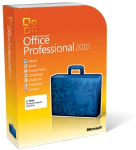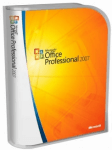98.7% Of all customers recommend us, we're so confident about our results we publish all reviews and stats
View Live Stats View ReviewsWhat's the difference between Office 2010 and Office 2007?
 |
VS |
 |
|
Interested in MS Office Training? We offer Microsoft Office Training in London and UK wide Including an Upgrade to Office 2010 course |
Also new in Office 2010...
Accessibility Checker
The Accessibility Checker helps people create Office content that is accessible to people with disabilities. A core feature of Word, Excel, and PowerPoint, the Accessibility Checker flags issues that can make content unreadable or difficult to read. In addition, organizations and governments that are concerned about compliance for employees can configure Group Policy settings to customize exactly which accessibility issues are checked.
Application virtualization
Microsoft Application Virtualization (App-V) is another method to deploy Office 2010. Virtualization transforms applications into virtualized, network-available services that are not installed on the users’ computer. Instead, applications can be automatically delivered to the users’ computer as users need them.
By using App-V and Office 2010 together, you can quickly deliver the latest version of Office without having to worry about application conflicts or delays in productivity for users. Deploying Office 2010 with App-V 4.6 (currently in Beta) includes new support for integration with SharePoint Products and Technologies, Outlook Search, and Microsoft OneNote 2010. App-V 4.6 is scheduled for release in 2010.
App-V significantly reduces regression and application interoperability testing. App-V also minimizes the effect on users during application upgrades, patching, and terminations of user rights to applications because restarts and uninstallations are no longer required.
Co-Authoring
Co-authoring simplifies collaboration by enabling multiple users to work productively on the same document without intruding on one another’s work or locking one-another out. This capability requires no additional server setup and is the default status for documents that are stored in Microsoft SharePoint Server 2010. Co-authoring is supported in Word 2010, PowerPoint 2010, and OneNote 2010. Co-authoring Excel 2010 workbooks in SharePoint is supported by using the Microsoft Excel Web App, which is included with Microsoft Office Web Apps.
Licensing and volume activation
Microsoft includes product activation technologies in the following products sold through the Volume Licensing channel: Windows Vista, Windows 7, Windows Server 2008, Windows Server 2008 R2, and now Office 2010. Product activation is verification with the manufacturer to confirm that software is genuine and that its product key is not compromised. Activation establishes a relationship between the software's product key and a particular installation of that software on a device.
Activation types include retail, volume, and OEM, and most require interactive steps by the user or IT professional, such as entering a product key from the packaging, or contacting a networked server or telephone service center. Activation technologies and tools vary according to the different channels for the software — retail, volume, and OEM.
The Microsoft policy requires the activation of all editions of Office 2010. This includes those obtained through a Volume Licensing program. This requirement applies to Office 2010 running on both physical computers and virtual machines.
You can use the following methods to activate Office 2010 with Office Activation Technologies:
- Key Management Service (KMS). KMS uses a KMS host key to activate a KMS host computer and establish a local activation service in your environment. Office 2010 connects to the local KMS host for activation.
- Multiple Activation Key (MAK). With a MAK, clients activate Office 2010 online with the Microsoft hosted activation servers or by telephone
- A combination of KMS and MAK.
Office 2010 64-bit editions
Processors that are 64-bit are quickly becoming the standard for systems ranging from servers to desktop computers. The 64-bit systems can use more virtual and physical memory than 32-bit processors. This lets users work with much larger data sets than they could previously, to analyze and solve large computational problems. Office 2010 introduces native 64-bit versions of Office products to take advantage of the additional capacity provided by 64-bit processors. This additional capacity is only needed by Office users who require Microsoft Excel spreadsheets that are larger than 2 GB, for example. The 32-bit version of Office 2010 provides the same functionality and is also compatible with 32-bit add-ins. This is why Office 2010 will install the 32-bit version by default.
Office Customization Tool changes
The Office Customization Tool (OCT) is the main customization tool that administrators use to customize an installation of Microsoft Office 2010 (and the 2007 Microsoft Office system). The OCT is part of the Setup program and is the recommended tool for most customizations, and is available only with volume licensed versions of Office 2010, such as Microsoft Office Professional Plus 2010. To determine whether an Office 2010 installation is a volume licensed version, check the Office 2010 installation disk to see whether it contains a folder named Admin. If the Admin folder exists, the disk is a volume license edition; otherwise, the disk is a retail edition.
Two architecture-specific versions of the OCT, one for 32-bit Office 2010 and one for 64-bit Office 2010. The 64-bit version of the OCT supports 64-bit client editions of Office 2010, and provides the same user interface, capabilities, and OPA settings as the 32-bit version. The OCT files are located in the Admin folder under the x86 (32-bit) and x64 (64-bit) folders, respectively.
Import feature that lets administrators import 32-bit OCT customization (.msp) updates into the 64-bit version of the OCT and 64-bit .msp updates into the 32-bit version of the OCT. This allows administrators of mixed environments (32-bit and 64-bit) to do the Setup customizations one time. For more information, see Import an Office 2010 Setup customization file.






